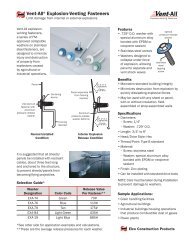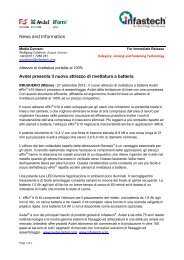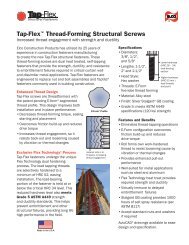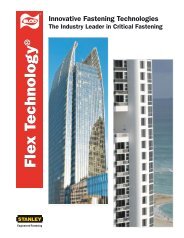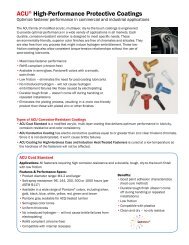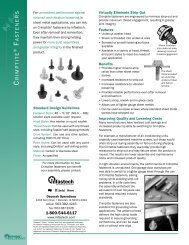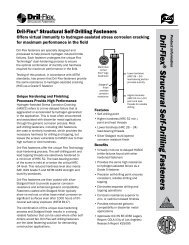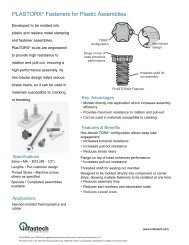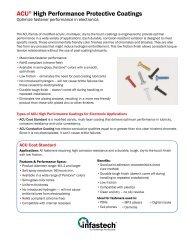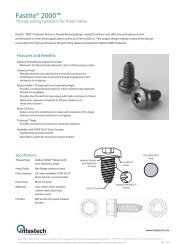Threaded Fasteners for plastic - Infastech
Threaded Fasteners for plastic - Infastech
Threaded Fasteners for plastic - Infastech
You also want an ePaper? Increase the reach of your titles
YUMPU automatically turns print PDFs into web optimized ePapers that Google loves.
t h e P r o P e r t i e s o F P l a s t i c s<br />
The fastening per<strong>for</strong>mance of <strong>plastic</strong>s<br />
is affected by several factors:<br />
• Flexural modulus (stiffness of<br />
material)<br />
• Filler and/or rein<strong>for</strong>cement content<br />
(amount of glass, etc. added to<br />
material)<br />
• Thermal expansion rate<br />
• Creep rate<br />
Tensile Strength<br />
Clamp Load (lbs/in)<br />
6<br />
-40°<br />
73°<br />
Strain (% Elongation)<br />
Time (min.)<br />
170°<br />
250°<br />
Flexural modulus<br />
Flexural modulus is the best indicator of how a <strong>plastic</strong> will respond<br />
to fasteners. Generally, the lower the flexural modulus, the more<br />
the material will flow and allow the <strong>for</strong>mation of threads.<br />
Thermo<strong>plastic</strong>s with a higher flexural modulus also allow the<br />
<strong>for</strong>mation of threads, but usually require a fastener with a low<br />
helix angle to avoid excessive drive torque.<br />
Plastics with a high flexural modulus, including thermosets, are<br />
too stiff <strong>for</strong> thread <strong>for</strong>ming and will require thread-cutting fasteners.<br />
There are definite exceptions to these guidelines which can<br />
adversely affect fastening per<strong>for</strong>mance. Involve our application<br />
specialists early in the design process to maximize joint reliability.<br />
The eFFecTs oF Fillers on FasTening<br />
Fillers and rein<strong>for</strong>cements change one or more properties of the<br />
thermo<strong>plastic</strong>. They can also affect fastening per<strong>for</strong>mance.<br />
For example, impact-resistant resins tend to act more ductile<br />
than their flexural modulus would indicate. Lubricants added <strong>for</strong><br />
molding, such as silicone, tend to reduce drive torque but can<br />
negatively affect clamp load.<br />
Again, it is important to test your application early in the design<br />
process to ensure optimal per<strong>for</strong>mance.<br />
Thermal exPansion raTe<br />
The stress/strain curve <strong>for</strong> thermo<strong>plastic</strong>s is very temperature<br />
dependent. Plastics expand much faster than metals do when<br />
subjected to the same thermal loading.<br />
Since very few joints operate at constant temperatures, thermal<br />
expansion or contraction is virtually universal. This will affect<br />
clamp load. However, this is only a problem if the application<br />
uses materials with dissimilar expansion rates and the<br />
temperature change is significant.<br />
creeP raTe<br />
Under load or heat all <strong>plastic</strong>s will creep, or permanently<br />
de<strong>for</strong>m. Creep will, in turn, cause a loss in clamp load. The chart<br />
at left demonstrates the loss of clamp load, at a stable<br />
temperature, over 64 hours <strong>for</strong> a #8 Plastite ® fastener driven<br />
into acetal resin.<br />
However, creep can be compensated <strong>for</strong> in joint design through a<br />
variety of methods. See page 9 <strong>for</strong> more details.



